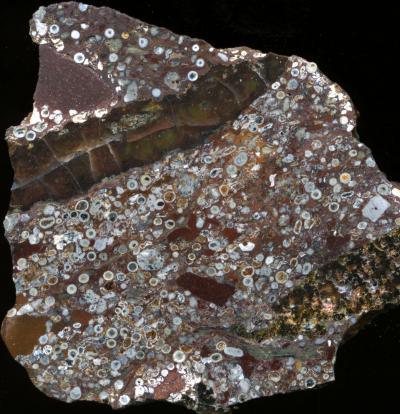
Key Takeaways:
After an expedition that spent about 10 days scouring the ocean floor off Papua New Guinea with a magnetic sled, Harvard University astrophysicist Avi Loeb says he has collected more than 700 metallic spherules that are now undergoing detailed examination in his lab at Harvard as well as at least two other independent labs that he asked to help out.
Loeb believes that many of these spherules, each less than a millimeter across (about the size of a pinhead), came from the first-ever interstellar meteorite to have been detected striking the Earth. He was able to pinpoint its entry location in the South Pacific through a combination of Department of Defense tracking data and seismic readings from two nearby locations.
“It’s the most exciting week of my scientific career,” Loeb told Astronomy in a shipboard Zoom interview during the expedition. In a followup interview after his return to Cambridge, he said the number of spherules identified in the collected material has continued to rise day by day.
Trawling for clues
Loeb says he expects to have collected enough data on these materials to be able to submit a formal paper to a peer-reviewed journal “hopefully within a month.” If the composition of these spherules differs in significant ways from that of any known solar system object or terrestrial contamination, it would go a long way toward convincing other scientists that the material is indeed from an interstellar object. That would make it only the third such object ever accepted as having been discovered – and the first one to be recovered on Earth. The interstellar asteroid ‘Oumuamua was the first, and Comet Borisov was the second.
His expedition took samples from areas of the seafloor far away from the expected landing site, as well as many samples from sections of the predicted path of molten droplets from the meteorite. Because ordinary meteorites from within the solar system are constantly bombarding the planet, there should be a background quantity of spherules deposited everywhere over time from these falls, as well as some from volcanic eruptions and human pollution. “We can tell the difference between material that came from Earth and material that came from a meteorite,” Loeb says. And by comparing the background spherules with those from the path, which could be a mix of background plus material from the interstellar meteorite, “we will be able to characterize the difference,” he says.
Loeb’s claims have been greeted skeptically by some fellow astronomers, but he says the data will tell the story, one way or the other. At a recent conference on asteroids, comets, and meteors, two astronomers presented talks disputing some of Loeb’s conclusions, including whether IM1 was really an interstellar object at all, and if so, whether any of it would have survived the flaming entry into the atmosphere to have reached the ground.
Tracing the path
Steven Desch, professor of astrophysics at Arizona State University, says his calculations show that assuming the object really did enter the atmosphere at 45 km/sec (about 28 miles per second), as reported by the Department of Defense sensors, “if it was iron, you can calculate easily how much of it would burn up, vaporize in the atmosphere, and it’s something on the order of 99.9999%.” That would mean there would be far too little material left to be detectable, he says, since it would be spread out over an area of many square miles.
Loeb points out that he and two of his students wrote a peer-reviewed paper “where we did a detailed modeling, and we calculated there should be thousands of spherules that should be found on the ocean floor. And so, we found them.” The analysis of the materials he recovered, once completed, should settle the question, he says.
Peter Brown, an astronomer at the University of Western Ontario, in Canada, has published a paper challenging the conclusion that IM1 was an interstellar object. Since the raw data on the fireball’s entry come from classified sensors and have not been released, Brown concludes that the velocity estimate was off by more than a factor of two, and as a result the object would have been an ordinary solar system meteor. “It comes down to the measurement uncertainty of the sensors, and of course we don’t know that,” he tells Astronomy.

If the velocity was indeed that much less, then the rest of its behavior can be explained as that of an ordinary stony meteorite, he argues. He points to a long history of claims of interstellar meteorites, all of which turned out to be based on measurement errors. He says analysis of several other meteors reported by the Defense sensors show significant errors compared to independent data.
Loeb counters that the U.S. Space Command took the extraordinary step of sending a letter to NASA confirming the accuracy of the calculations showing the object was interstellar.
Benjamin Weiss, a professor of planetary sciences at MIT and a specialist in the analysis of meteorites, agrees that the test results on the spherules are the key. “The first thing I would want to know is their bulk composition, which I know he is working on.” Then, analyzing the distribution of the materials recovered in relation to the predicted entry path, “that would be an important demonstration, and also a huge challenge.” Locating materials from any specific identified meteorite fall would be a significant accomplishment, he tells Astronomy, even if it turns out not to be interstellar after all.
“There’s definitely a mountain of challenges ahead,” Weiss says. “But it’s a clearly defined one. … There are a bunch of metrics that he can meet, or not, and that he can use to establish the origin of these things. It’s not like we don’t know how to approach this.”
One way or another, he says, we are at the beginning of a new era of exploration, particularly with the planned opening in 2025 of the Vera Rubin Telescope in Chile, which is expected to discover thousands of new asteroids, and likely will find many more interstellar objects as well. “Regardless of this particular object,” Weiss says, “this is just the beginning of an exciting time, the discovery and eventual characterization of interstellar objects.”









